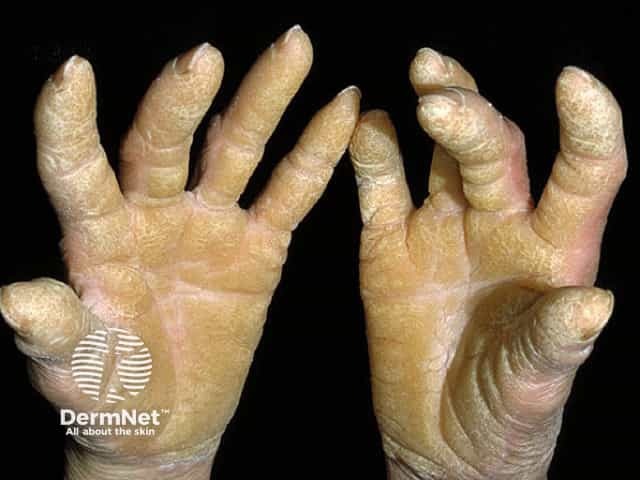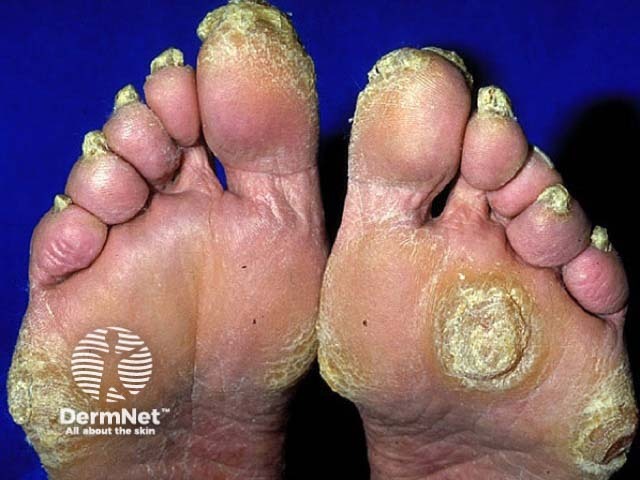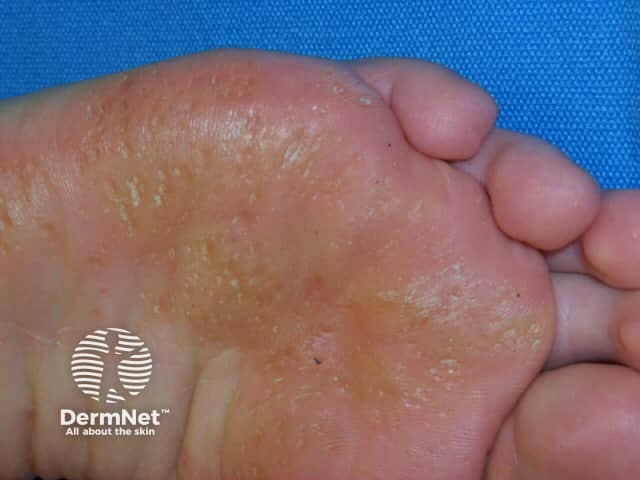Main menu
Common skin conditions

NEWS
Join DermNet PRO
Read more
Quick links
Palmoplantar keratoderma — extra information
Palmoplantar keratoderma
Author: Dr Amy Stanway, Dermatology Registrar, Nottingham, United Kingdom, 2005.
What is palmoplantar keratoderma?
‘Keratoderma’ is a term that means marked thickening of the epidermis of the skin.
‘Palmoplantar’ refers to the skin on the soles of the feet and palms of the hands; these are the areas keratoderma affects most often. Palmoplantar keratoderma is also sometimes known as ‘keratosis palmaris et plantaris’.
Classification of keratodermas depends on whether it is inherited or acquired, and the clinical features.
- Diffuse keratodermas affect most of the palms and soles.
- Focal keratodermas mainly affect pressure areas.
- Punctate-type keratoderma results in tiny bumps on the palms and soles.
- Most often the abnormal skin involves only the palms and soles (non-transgradient palmoplantar keratoderma) but sometimes it extends on to the top of the hands and feet as well (transgradient).
In some rare syndromic forms of keratoderma other organs in the body may be affected in addition to the skin, and the keratoderma can be a marker of this internal abnormality.

Diffuse palmoplantar keratoderma

Focal palmoplantar keratoderma

Punctate keratoderma
What causes palmoplantar keratoderma?
Keratoderma may be inherited (hereditary) or, more commonly, acquired.
- Hereditary keratoderma: the condition runs in families and is passed down or from one or both parent(s) to their children
- Acquired keratoderma: the condition is not inherited and occurs as a result of a change in the health or the environment of the affected person
The hereditary keratodermas are caused by a gene abnormality that results in abnormal skin protein (keratin). They may be inherited either by an autosomal dominant or autosomal recessive pattern.
- Autosomal dominant keratodermas are likely to occur in every generation of a family. If one parent is affected there is a 50% chance that each child will be affected.
- Autosomal recessive keratodermas occur less commonly within an affected family. This is because both parents need to pass on an abnormal gene to the child for it to be affected. People with one affected gene only do not have the condition themselves but carry the abnormal gene and are referred to as ‘carriers’ of the disease. They may pass on the abnormal gene to their children but the children will only be affected if their other parent also carries an abnormal gene and passes it on to the same child.
- A specific gene mutation may be found within 13 different genes.
Specific types of keratoderma
The table below lists the main types of hereditary palmoplantar keratoderma (PPK).
Diffuse hereditary palmoplantar keratodermas
- Unna-Thost type (autosomal dominant)
- Vorner's type (autosomal dominant)
- Mal de Meleda type (autosomal dominant or recessive)
- Huriez syndrome (autosomal dominant)
- Olmsted syndrome (unknown inheritance pattern)
- Vohwinkel syndrome (autosomal dominant)
- PPK with sensorineural deafness (mitochondrial inheritance)
- Bart-Pumphrey syndrome (autosomal dominant)
- Hidrotic ectodermal dysplasia (autosomal dominant)
- Papillon-Lefevre syndrome (autosomal recessive)
- Palmoplantar keratoderma Nagashima type (autosomal recessive)
- Diffuse palmoplantar keratoderma with woolly hair and arrythmogenic cardiomyopathy (autosomal recessive)
Focal hereditary palmoplantar keratodermas
- Palmoplantar keratoderma striata/areata type (autosomal dominant)
- Hereditary painful callosities (autosomal dominant)
- Howel-Evans syndrome or tylosis (autosomal dominant)
- Richner-Hanhart syndrome (autosomal recessive)
- Pachyonychia congenita (autosomal dominant)
- Striate palmoplantar keratoderma with woolly hair and dilated cardiomyopathy (autosomal recessive)
Punctate palmoplantar keratodermas
- Punctate keratoderma (autosomal dominant)
- Filiform keratoderma (autosomal dominant)
- Marginal keratoderma (acrokeratoelastoidosis, autosomal dominant)
Acquired palmoplantar keratodermas may be focal or diffuse. They may arise in association with a variety of different skin and internal conditions.
- An inflammatory skin condition (eg, eczema or psoriasis)
- Infections
- Medications and toxins
- An internal cancer
- A systemic inflammatory disease
- Circulation problems
- Sun damage
What is the treatment of palmoplantar keratoderma?
The following treatments soften the thickened skin and makes it less noticeable.
- Emollients
- Keratolytic agents (eg, 6% salicylic acid, 70% propylene glycol, 30% water)
- Topical retinoids
- Topical vitamin D ointment (calcipotriol)
- Oral retinoids (acitretin)
On DermNet
- Diffuse hereditary palmoplantar keratoderma
- Hereditary focal palmoplantar keratoderma
- Punctate keratoderma
- Acquired keratoderma
- Marginal keratoderma
- Cracked heels
- Foot skin problems
- Hand skin problems
- Kava dermopathy
- Melanoma in skin of colour
Other websites
- Keratosis Palmaris et Plantaris — Medscape Reference
- Keratinization Disorders — geneSkin
Books about skin diseases
